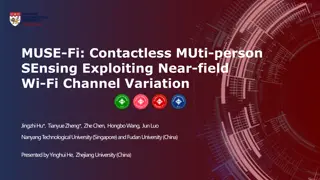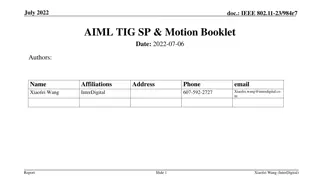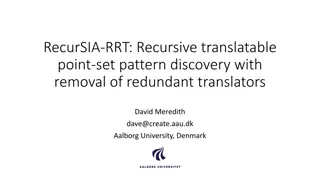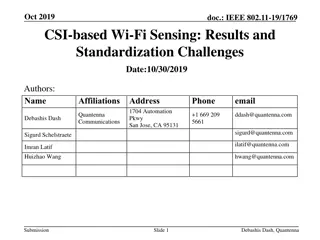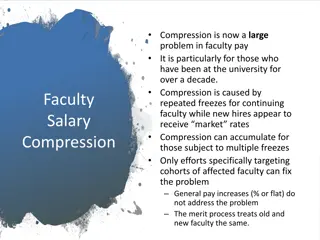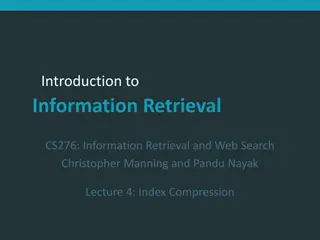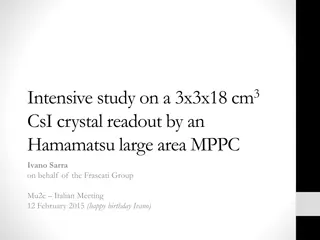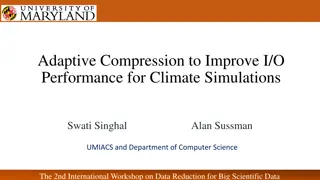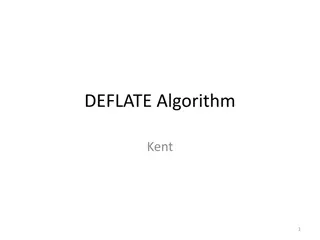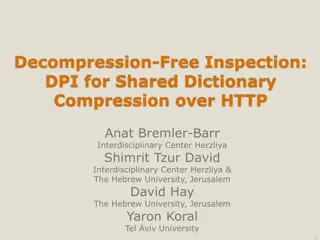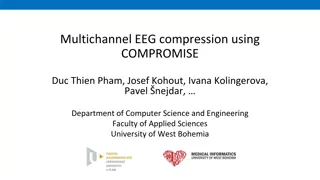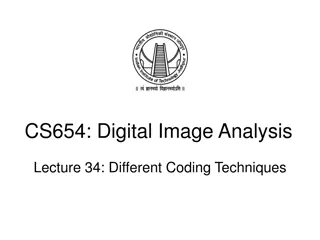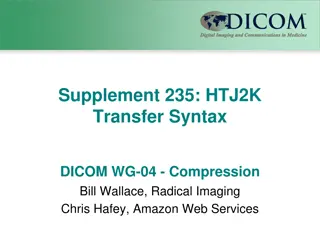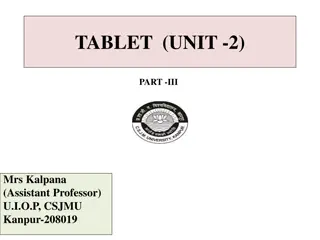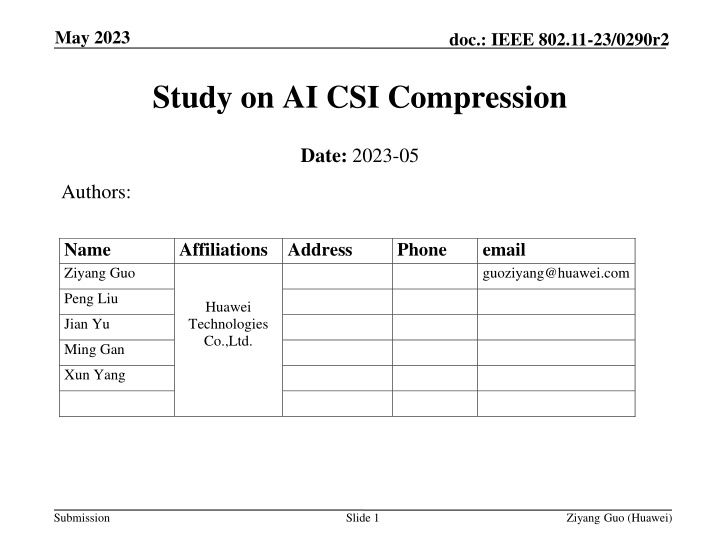
Study on AI CSI Compression for IEEE 802.11-23 Network
"Explore the advancements in AI-based CSI compression technology for IEEE 802.11-23 networks, focusing on the VQ-VAE method, ML and AI solutions, and the potential for reducing feedback overhead and improving system throughput. Dive into the technical details and future implications discussed in this comprehensive study."
Download Presentation

Please find below an Image/Link to download the presentation.
The content on the website is provided AS IS for your information and personal use only. It may not be sold, licensed, or shared on other websites without obtaining consent from the author. If you encounter any issues during the download, it is possible that the publisher has removed the file from their server.
You are allowed to download the files provided on this website for personal or commercial use, subject to the condition that they are used lawfully. All files are the property of their respective owners.
The content on the website is provided AS IS for your information and personal use only. It may not be sold, licensed, or shared on other websites without obtaining consent from the author.
E N D
Presentation Transcript
May 2023 doc.: IEEE 802.11-23/0290r2 Study on AI CSI Compression Date: 2023-05 Authors: Name Ziyang Guo Affiliations Address Huawei Technologies Co.,Ltd. Phone email guoziyang@huawei.com Peng Liu Jian Yu Ming Gan Xun Yang Submission Slide 1 Ziyang Guo (Huawei)
May 2023 doc.: IEEE 802.11-23/0290r2 Abstract In previous contribution (r0&r1) [5], we reviewed some existing works on AI CSI compression, introduced a new vector quantization variational autoencoder (VQ- VAE) method for CSI compression, discussed the performance and possible future work. In this updated version (r2), we have a follow-up discussion on the proposed VQVAE method, including Feedback overhead reduction and goodput improvement, Generalization of different channel models, Generalization of different numbers of receive antennas. Submission Slide 2 Ziyang Guo (Huawei)
May 2023 doc.: IEEE 802.11-23/0290r2 Background The AP initiates the sounding sequence by transmitting the NDPA frame followed by a NDP which is used for the generation of V matrix at the STA. The STA applies Givens rotation on the V matrix and feeds back the angels in the beamforming report frame. ??+?? ? and number of antennas lead to significantly increased sounding feedback overhead, which increases the latency and limits the throughput gain. Visualization of the precoding matrix after FFT shows its sparsity and compressibility. ??? The total feedback overhead is ?? ??. Larger bandwidth Ntx=Nrx=Nss BW=20MHz BW=40MHz BW=80MHz BW=160MHz BW=320MHz 2 0.12 (KBytes) 0.24 0.50 1.00 1.99 4 0.73 1.45 2.99 5.98 11.95 8 3.39 6.78 13.94 27.89 55.78 16 14.52 29.04 59.76 119.52 239.04 20MHz, 8*2 Submission Slide 3 Ziyang Guo (Huawei)
May 2023 doc.: IEEE 802.11-23/0290r2 Existing Work on AI CSI Compression ML solutions: no neural network [1][2] adopted a traditional machine learning algorithm, i.e., K-means, to cluster the angle vector after Givens rotation Beamformer and beamformee need to exchange and store the centroids Only transmit the centroid index during inference 2dB PER loss, up to 50% goodput improvement AI solutions: use neural network [3] adopted two autoencoders to compress two types of angles after Givens rotation separately Beamformer and beamformee need to exchange the store neural network models Only transmit the encoder output during inference Up to 70% overhead reduction and 60% throughput gain for 11ac system Submission Slide 4 Ziyang Guo (Huawei)
May 2023 doc.: IEEE 802.11-23/0290r2 Our Study on AI CSI Compression Vector quantization variational autoencoder (VQVAE) [4] is proposed for CSI compression Consists of encoder, codebook, decoder Learn how to compress and quantize automatically from the data Convolutional neural network (CNN) or transformer could be used for both the encoder and decoder. Input of NN could be the V matrix or the angles after Givens rotation. Beamformer and beamformee need to exchange and store the codebook and half of the NN model. Only transmit the codeword index during inference. Submission Slide 5 Ziyang Guo (Huawei)
May 2023 doc.: IEEE 802.11-23/0290r2 Performance Evaluation Simulation setup: Training data are generated under SU MIMO, channel D NLOS, BW=80MHz, Ntx=8, Nrx=2, Nss=2, Ng=4 TNDPA=28us, TNDP=112us, TSIFS=16us, Tpreamble=64us, MCS=1 for BF report, MCS=7 for data, payload length=1000Bytes Comparison Baseline: current methods in the standard, Ng=4 (250 subcarriers) and Ng=16 (64 subcarriers) with ??= 6 and ??= 4 Performance Metric: Goodput: GP = successful data transmitted ? (1 ???) = total time duration ?????+????+???+?????+????+4 ????? Compression ratio: Rc = legacy BF feedback bits AI BF feedback bits SIFS SIFS SIFS SIFS SNR-PER curve: target PER is 10-2 Data NDPA NDP BF ACK Submission Slide 6 Ziyang Guo (Huawei)
May 2023 doc.: IEEE 802.11-23/0290r2 Performance Evaluation Loss @ 0.01 PER (dB) vs Ng=4 0.16 0.5 loss @ 0.01 PER (dB) vs Ng=16 0 0.4 overhead Ng=4 (bits) overhead Ng=16 (bits) overhead VQVAE (bits) Rc Rc GP Ng=4 (Mbps) GP Ng=16 (Mbps) GP AI (Mbps) GP gain (%) vs Ng=4 GP gain (%) vs Ng=16 Method vs Ng=4 vs Ng=16 VQVAE-1 VQVAE-2 32500 32500 8320 8320 2560 1280 12.70 25.39 3.25 6.50 5.07 5.07 10.77 10.77 14.70 16.00 189.64 215.20 36.48 48.53 Submission Slide 7 Ziyang Guo (Huawei)
May 2023 doc.: IEEE 802.11-23/0290r2 Further Study in r2 Reduce the feedback overhead and improve the goodput Different neural network architecture Reduce codebook size and dimension More complex scenarios More simulations under different configurations MU-MIMO scenarios Increase model generalization One neural network can exhibit robustness to different channel models One neural network can exhibit robustness to different bandwidth One neural network can exhibit robustness to number of antennas Submission Slide 8 Ziyang Guo (Huawei)
May 2023 doc.: IEEE 802.11-23/0290r2 Feedback overhead reduction and goodput improvement Simulation setup: SU MIMO, channel D NLOS, BW=80MHz, Ntx=8, Nrx=Nss=2 Higher compression ratio and more MCS are considered Comparison baseline Standard: Givens, Ng=4/16, ??=6, ??=4 VQVAEs with different compression ratios achieve less than 1dB PER loss compared with standard method. Rc=12 (CB size 1024) Rc=25 (CB size 1024) Rc=36 (CB size 128) Submission Slide 9 Ziyang Guo (Huawei)
May 2023 doc.: IEEE 802.11-23/0290r2 Goodput improvement and feedback overhead reduction SIFS Performance Metric: Goodput: GP = successful data transmitted SIFS SIFS SIFS Data NDPA NDP total time duration ? (1 ???) BF ACK = ?????+????+???+?????+????+4 ????? Compression ratio: Rc = legacy BF feedback bits AI BF feedback bits Parameters for goodput calculation: TNDPA=28us, TNDP=112us, TSIFS=16us, Tpreamble=64us, MCS=1 for BF report, MCS=7 for data, L=1000Bytes, PER=0.01 overhead VQVAE (bits) 2560 1280 896 Loss @ 0.01 PER (dB) vs Ng=4 0.16 0.5 0.9 loss @ 0.01 PER (dB) vs Ng=16 0 0.4 0.8 GP GP gain (%) vs Ng=4 189.64 215.20 223.77 GP gain (%) vs Ng=16 36.48 48.53 52.57 overhead Ng=4 (bits) overhead Ng=16 (bits) Rc Rc GP Ng=4 (Mbps) GP AI (Mbps) Method VQ size Ng=16 (Mbps) 10.77 10.77 10.77 vs Ng=4 vs Ng=16 VQVAE-1 VQVAE-2 VQVAE-3 1024 1024 128 32500 32500 32500 8320 8320 8320 12.70 25.39 36.27 3.25 6.50 9.29 5.07 5.07 5.07 14.70 16.00 16.43 Submission Slide 10 Ziyang Guo (Huawei)
May 2023 doc.: IEEE 802.11-23/0290r2 Generalization of different channel models Simulation setup: Training data are a combination of V matrices generated under channel model B, C, and D The trained model is tested by data of channel B, C, and D, respectively Comparison baseline VQVAE-chX: NN model is trained and tested using data of channel X Standard-chX: Ng=4, ??=6, ??=4 Compared with standard method, the generalized NN model has no PER loss for channel B and C, and 0.5dB PER loss for channel D. A well-trained neural network model is robust to different channel conditions. Legend Train data Test data VQVAE-generalized-chB B, C, D B VQVAE-chB B B VQVAE-generalized-chC B, C, D C VQVAE-chC C C Submission Slide 11 Ziyang Guo (Huawei)
May 2023 doc.: IEEE 802.11-23/0290r2 Generalization of different Nrx/Nss Simulation setup: Training data are a combination of V matrices of different Nrx (i.e., Nrx=2 and 4) The trained model is tested by data of Nrx=2 and Nrx=4, respectively Comparison baseline VQVAE: NN model is trained and tested using data of certain Nrx Standard: Ng=4, ??= 6, ??= 4 Compared with standard method, the generalized NN model has 0.2/0.8dB PER loss for Nrx=2/4. A well-trained neural network model is robust to different number of receive antennas. Legend Train data Test data VQVAE-generalized-8x4 8x2 + 8x4 8x4 VQVAE-8x4 8x4 8x4 VQVAE-generalized-8x2 8x2 + 8x4 8x2 VQVAE-8x2 8x2 8x2 Submission Slide 12 Ziyang Guo (Huawei)
May 2023 Workflow of AI CSI compression using autoencoder doc.: IEEE 802.11-23/0290r2 AP STA AP STA Training and model sharing NDP Channel estimation, SVD, Givens rotation V or ?,? NDP Train the encoder, codebook and decoder Channel estimation, SVD encoder and codebook V V Index Decoder, codebook Encoder, codebook NN model training Infrequently: hours, days or even months Original V can be feedbacked to facilitate training if possible Standardize the encoder architecture; alternatively, negotiate encoder architecture using existing format such as NNEF[6] and ONNX[7] beamforming Data Submission Slide 13 Ziyang Guo (Huawei)
May 2023 doc.: IEEE 802.11-23/0290r2 Summary In this contribution, we showed performance enhancement for VQVAE-based CSI compression scheme proposed in [5], including Further feedback overhead reduction and goodput improvement, NN model generalization of different channel models, NN model generalization of different numbers of receive antennas. We also presented the workflow of AI CSI compression using autoencoder. Further study Robustness to different bandwidths and number of transmit antennas MU-MIMO scenarios Complexity reduction Submission Slide 14 Ziyang Guo (Huawei)
May 2023 doc.: IEEE 802.11-23/0290r2 References [1] M. Deshmukh, Z. Lin, H. Lou, M. Kamel, R. Yang, I. G ven , Intelligent Feedback Overhead Reduction (iFOR) in Wi-Fi 7 and Beyond, in Proceedings of 2022 VTC-Spring [2] 11-22-1563-02-aiml-ai-ml-use-case [3] P. K. Sangdeh, H. Pirayesh, A. Mobiny, H. Zeng, LB-SciFi: Online Learning-Based Channel Feedback for MU-MIMO in Wireless LANs, in Proceedings of 2020 IEEE 28th ICNP [4] A. Oord, O. Vinyals, Neural discrete representation learning, Advances in neural information processing systems, 2017. [5] 11-23-0290-01-aiml-study-on-ai-csi-compression [6] The Khronos NNEF Working Group, Neural Network Exchange Format , https://www.khronos.org/registry/NNEF/specs/1.0/nnef-1.0.5.html [7] Open Neural Network Exchange (ONNX), https://onnx.ai Submission Slide 15 Ziyang Guo (Huawei)


